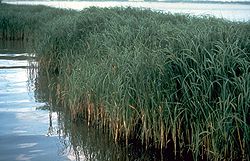
Halophyte
Encyclopedia

A halophyte is a plant
Plant
Plants are living organisms belonging to the kingdom Plantae. Precise definitions of the kingdom vary, but as the term is used here, plants include familiar organisms such as trees, flowers, herbs, bushes, grasses, vines, ferns, mosses, and green algae. The group is also called green plants or...
that grows where it is affected by salinity
Salinity
Salinity is the saltiness or dissolved salt content of a body of water. It is a general term used to describe the levels of different salts such as sodium chloride, magnesium and calcium sulfates, and bicarbonates...
in the root area or by salt spray, such as in saline semi-deserts, mangrove swamps, marshes and sloughs, and seashores. An example of a halophyte is the salt marsh grass Spartina alterniflora
Spartina alterniflora
Spartina alterniflora is a perennial deciduous grass which is found in intertidal wetlands, especially estuarine salt marshes. It grows 1-1.5 m tall, and has smooth, hollow stems which bear leaves up to 20-60 cm long and 1.5 cm wide at their base, which are sharply tapered and bend down...
(smooth cordgrass). Relatively few plant species are halophytes - perhaps only 2% of all plant species. The large majority of plant species are "glycophytes", and are damaged fairly easily by salinity.
One quantitative measure of salt tolerance is the "total dissolved solids" in irrigation water that a plant can tolerate. Sea water typically contains 40 grams per litre (g/l) of dissolved salts (mostly sodium chloride). Beans and rice
Rice
Rice is the seed of the monocot plants Oryza sativa or Oryza glaberrima . As a cereal grain, it is the most important staple food for a large part of the world's human population, especially in East Asia, Southeast Asia, South Asia, the Middle East, and the West Indies...
can tolerate about 1-3 g/l, and are considered glycophytes (as are most crop plants). At the other extreme, Salicornia bigelovii (dwarf glasswort) grows well at 70 g/l of dissolved solids, and is a promising halophyte for use as a crop.
Plants such as barley (Hordeum vulgare) and the date palm (Phoenix dactylifera) can tolerate about 5 g/l, and can be considered as marginal halophytes.
Adaptation to saline environments by halophytes may take the form of salt tolerance (see halotolerance
Halotolerance
Halotolerance is the adaptation of living organisms to conditions of high salinity. Halotolerant species tend to live in areas such as hypersaline lakes, coastal dunes, saline deserts, salt marshes, and inland salt seas and springs. Halophiles are a group of bacteria that live in highly saline...
) or salt avoidance. Plants that avoid the effects of high salt even though they live in a saline environment may be referred to as facultative halophytes rather than 'true', or obligatory, halophytes.
For example, a short-lived plant species that completes its reproductive life cycle during periods (such as a rainy season) when the salt concentration is low would be avoiding salt rather than tolerating it. Or a plant species may maintain a 'normal' internal salt concentration by excreting excess salts through its leaves or by concentrating salts in leaves that later die and drop off.
Halophytes as Biofuel
Some halophytes are being studied for use as "3rd generation" biofuel precursors. Halophytes such as Salicornia bigeloviiSalicornia bigelovii
Salicornia bigelovii is a species of flowering plant in the amaranth family known by the common names dwarf saltwort and dwarf glasswort. It is native to coastal areas of the eastern and southern United States, as well as southern California and coastal Mexico. It is a plant of salt marshes, a...
can be grown in harsh environments and typically do not compete with food crops for resources, making them promising sources of biodiesel
Biodiesel
Biodiesel refers to a vegetable oil- or animal fat-based diesel fuel consisting of long-chain alkyl esters. Biodiesel is typically made by chemically reacting lipids with an alcohol....
or bioalcohol.
See also
- AtriplexAtriplexAtriplex is a plant genus of 100-200 species, known by the common names of saltbush and orache . The genus is quite variable and widely distributed. It includes many desert and seashore plants and halophytes, as well as plants of moist environments...
(saltbush) (orache) (orach) - Babassu
- SwitchgrassSwitchgrassPanicum virgatum, commonly known as switchgrass, is a perennial warm season bunchgrass native to North America, where it occurs naturally from 55°N latitude in Canada southwards into the United States and Mexico...
- Yerba mansa
- Tetragonia tetragonoidesTetragonia tetragonoidesTetragonia tetragonioides is a leafy groundcover also known as New Zealand Spinach, Warrigal Greens, Kokihi , Sea Spinach, Botany Bay Spinach, Tetragon and Cook's Cabbage...
(Warrigal greens, a leaf vegetable used somewhat like spinach or silver beet)

